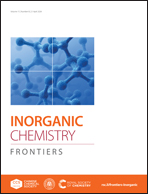Understanding the synthesis mechanism, chemical structures and optical properties of aromatic carbon nitride†
Abstract
Aromatic carbon nitride (PhCN), as an emerging semiconductor material, has attracted much attention due to its excellent optical properties. Fully understanding the synthesis mechanism, chemical structure, and optical properties of PhCN would significantly promote its progress in synthesis, modifications and applications. Here the chemical structures and optical properties of PhCN and intermediates have been systematically studied, and hereby the synthesis mechanism of PhCN is explicitly proposed for the first time. The results show that the precursor 2,4-diamino-6-phenyl-1,3,5-triazine (DPT) is deaminated to form the DPT dimer, trimer and polymers, and then the triazine was isomerized to tri-s-triazine by a ring-opening isomerization reaction to form PhCN. Meanwhile, the correlation between structural and optical properties of PhCN and intermediates demonstrates the electron delocalization effect of the phenyl group and reveals that highly polymerized PhCN has a more stable molecular structure, thus exhibiting more stable photophysical properties. Our work provides a fundamental study from synthesis to structures and optical properties of PhCN, which will certainly promote its deeper research and wider application.



 Please wait while we load your content...
Please wait while we load your content...